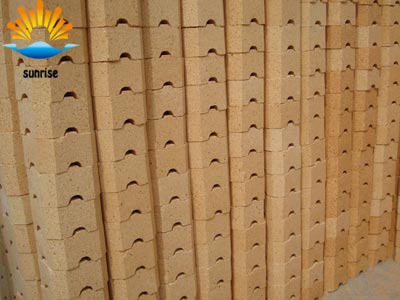Refractory knowledge
- How to Bake High Alumina Bricks
- The impact of Sino-US trade war on the re
- Physical properties of refractory materia
- The origin and development of refractory
- Application of Lightweight Clay Brick in
- How to improve the insulation performance
- Improve the service life of chrome corund
- Introduction to the production process of
Hot Products
High alumina brick knowledge introduction
The mineral composition of high-alumina bricks is determined according to the bauxite used. The mineral composition of clinker is generally mullite, corundum and glassy phases. The theoretical composition of mullite is 71.8% of Al2O3 and 28.2% of SiO2, and its melting decomposition temperature is 1840°C. With acicular crystals, network cross structure, high temperature shows good strength. Corundum exists in the form of α-Al2O3 with a melting point of 2050°C, a hardness of Mohs9, grain and columnar crystals, good chemical stability, and a high temperature mechanical property for both acid and alkaline slags. Not entirely dependent on high aluminum. The Al2O3 content in the brick depends more on the shape of the crystal formed and the amount of glass phase, composition and viscosity. The research on creep test or rigid modulus and modulus of rupture of high alumina bricks shows that the high temperature mechanical properties of mullite bricks are better than those of high Al2O3 bricks. LZ-75 high-alumina bricks, despite the formation of a large number of high-refibre α-corundum crystals, grain, columnar, its microstructure is as strong as the mullite structure, but a small amount of glass under the stress of intercrystalline The liquid causes it to slip, causing structural deformation and decreased strength. Mullite bricks, such as LZ-65 and LZ-55 grades, are mainly mullite crystals. They are needle-like and form a cross-over network structure. During the filling of the glass phase, they can withstand stress, are not easily deformed, and have good high-temperature strength. In particular, the bricks made of sillimanite materials have high purity, and they are burned to form mullite and SiO2 with the exception of a small amount of SiO2 and a very small amount of impurities to form a glass phase. The rest of the SiO2 is generated in cristobalite and filled in between the mullite crystals. , Produce permanent expansion after cooling. The brick exhibits good creep resistance over a long period of use. LZ-48 bricks, despite the formation of mullite crystals, are submerged in a large amount of glass, so the high temperature mechanical strength is poor, but the normal temperature compressive strength is better. Thus, the creep rate at constant speed is different. The transition temperature of the LZ-75 grade bricks was between 1120 and 1130°C; the transition temperature of the LZ-48 grade bricks was at 1050°C; and no turning point was observed in the mullite bricks. High-temperature rupture modulus and stiffness modulus of high-alumina bricks based on mullite and corundum began to change at 800°C; tensile strength began to change near 1000°C, and they all had one thing in common, that is, at room temperature to 1000°C. Between them, the intensity increases with increasing temperature, reflecting the thermal expansion of the two crystalline phases to reduce the residual internal stress, bridging the micro-cracks, resulting in increased strength. Definite resistance. Lightweight clay bricks have a high degree of refractoriness, can resist high temperature heat loads, do not soften, and do not melt. Lightweight clay bricks should have high strength and high temperature resistance strength, high load softening temperature, high creep resistance, can resist the joint effects of high temperature heat load, do not lose strength, no creep and collapse. Lightweight clay bricks should have good thermal shock resistance, slag resistance, high compactness, wear resistance, good impact resistance and chemical stability. Lightweight clay bricks have high volume stability, residual shrinkage and residual swelling are small, there is no crystal transformation and a serious volume effect, the volume does not shrink and only uniform expansion.
High-aluminum bricks to avoid coloring method: the use of strong magnetic separation of high-titanium bauxite in addition to iron, try to avoid the coexistence of iron, titanium ions; change the high alumina brick kiln location, as far as possible installed in the middle of the kiln, avoid installation in the fire box Nearby; increase the amount of hot air, resulting in oxygen-rich operation, to avoid reducing the atmosphere; in the cooling process, slowly cooling, so that low-valent iron, titanium ions reoxidation and decolorization.









